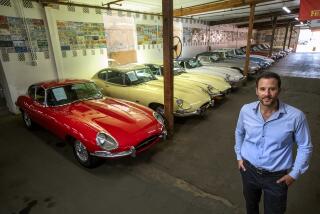Take me to your leader
- Share via
Except for reasons of brevity, the title of the Petersen Automotive Museum’s new exhibit “Presidents, Popes and Potentates: Cars of Heads of State” might have included the words “tyrants,” “kleptocrats,” “stooges” and “all-around murderous jerks.”
Among the exhibit’s offerings: the shah of Iran’s 1939 Bugatti 57C; the tugboat-sized Hongqi limousine used by the Chinese-installed Dalai Lama of Tibet; the 1939 Packard Super Eight Phaeton owned by Juan and Eva Peron (the original power-corrupts couple); and exiled Philippine dictator Ferdinand Marcos’ armored 1988 Mercedes-Benz SEL, equipped with oil sprayers under the rear bumper, a la James Bond, and smoke nozzles to befog would-be pursuers.
“This was a guy with a lot of people mad at him,” observes curator Leslie Kendall.
If these cars could talk, chances are they would have been quietly executed by now. As it is, they live on as shining examples of power wedded to horsepower.
Since at least the time of the Roman triumphs, royal processions were calculated to stun the masses into reverent submission. As Kendall writes in the exhibit notes, a monarch’s job is to be seen, and before mass communication these state occasions offered a rare chance for the ruled to look upon their rulers.
The massive motorcade cars in the collection -- such as the Hooper-bodied Rolls-Royce Silver Wraith used by the British royals in Australia -- served to ratify both king and country.
“When heads of state drive cars,” says Kendall, “or are seen in cars, they are not speaking only for themselves but for the whole country. It’s important to look as good, and prosperous and modern, as possible. And it confers on the head of state his nation’s pride: ‘Oh, look, there’s my leader.’ You wouldn’t want to see President Bush riding around in a Yugo, would you?”
Unfortunately, automobiles and firearms were perfected more or less at the same time, a circumstance that helped kick off World War I with the assassination of Archduke Franz Ferdinand, killed in a motorcade in Sarajevo in 1914. Since then, heads of state have had to strike a balance between -- to put it bluntly -- being seen and being shot.
And not just ruthless despots; good guys need protection too. The reformist president of Mexico, Lazaro Cardenas -- by all accounts an incorruptible man who despised official pomp -- was nonetheless obliged to be transported in a heavily armored 1938 Packard Twelve Touring Cabriolet, body by Brunn. Uneasy lies the head that nationalizes the oil industry.
Precisely because it was so important for citizens to see the president incarnate, open-top presidential cars were the rule for much of the 20th century. Parked on the Petersen’s second level is the 1953 Cadillac Eldorado two-door convertible that Dwight D. Eisenhower rode in his first inauguration. Kendall regards this as a classic example of presidential product placement. Also on display is a Chrysler Imperial Dual Cowl Phaeton, an open parade car used by the Eisenhower White House.
If it seems like American presidents were pushing their luck, they were. After the assassination of President John F. Kennedy in Dallas in 1963, American presidents gradually withdrew into the rolling revetments of modern presidential limousines, becoming all but invisible behind tinted ballistic glass. Kennedy’s X-100 Lincoln Continental limousine -- which is on permanent display at the Henry Ford Museum in Dearborn, Mich. -- was retrofitted with a permanent top and transparent armor. There are no open-top cars in the presidential garage these days.
It’s hard not to mourn the passing of the motorcade, harder still to judge it. Just because you are paranoid doesn’t mean everybody’s not out to get you.
The exhibit, which runs through early next year, provides one wonderful exception. In 1981, Pope John Paul II, standing in an open car, was nearly killed by a would-be assassin in St. Peter’s Square. The next year, the Vatican unveiled the most famous “Popemobile,” the pontiff-under-glass parade car built on a 1982 Range Rover for a tour of Britain.
But the Holy Father, apparently, didn’t like being walled off from the crowds by bulletproof glass and so, in 1999 during a visit to Mexico, he undertook a risky 22-mile parade route in an open-top Cadillac De Ville Parade Phaeton, also in the exhibit. This car, with a hydraulically elevated captain’s chair in the back, made the pope an easy target. Say what you want about John Paul II; he was no coward.
There are some purely sensational automobiles here, gob-smacking glories from the world’s most aristocratic motor pools. Indulge your senses with the 1935 Duesenberg SJ Convertible Coupe (body by the English coachbuilder Gurney Nutting), a vast boat-tailed sports car that once belonged to the Maharajah of Indore.
This massive, 18-foot-long car, one of the last Duesenbergs ever built, was powered by a 400-horsepower supercharged straight-eight engine at a time when most cars had less than 100 horsepower under the hood. On the front fenders are sets of red and blue lights. These lights indicated whether the maharajah or his wife was driving, so that, as the car approached the house, the appropriate retinue could be summoned.
There is a grave undercurrent to these cars, some of which are, after all, spoils of cruel colonial oligarchies. Wealth is seldom innocent. Yet, when you consider the fate of some of their owners -- the shah of Iran, the prince regent of Iraq -- there’s also a sense of rough justice.
It’s good to be king “as long as it lasts,” says Kendall.
*
(BEGIN TEXT OF INFOBOX)
Petersen exhibit
What: “Presidents, Popes, and Potentates: Cars of Heads of State”
Where: Petersen Automotive Museum, 6060 Wilshire Blvd., Los Angeles, (323) 930-2277
When: Through Jan. 22, 2006. 10 a.m. to 6 p.m. Tuesday to Sunday.
Admission: $10; seniors 62 and older and children 5 to 12, $5.
Automotive critic Dan Neil can be reached at dan.neil@latimes.com.






